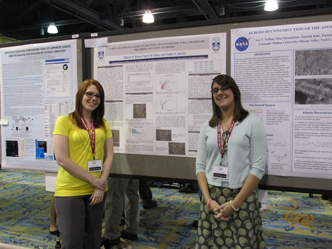Flagstaff may not be the center of the space exploration universe, but a constellation of science-based organizations hopes a systematic approach will draw more attention to capabilities in the region.
That conviction is one of the motivations behind a public poster session being sponsored by the Northern Arizona Planetary Science Alliance. The community, students and scientists are welcome to attend the event being held from 1–4 p.m. Wednesday, Sept. 16, at the DuBois Center Ballroom on the Northern Arizona University campus.
“People in Arizona hear ‘planetary science’ and they think Tucson or Phoenix, and that’s it,” said Nadine Barlow, professor of physics and astronomy at NAU. “We’re hoping to bring to the forefront that there’s actually a fair amount of research being done up in this area.”
NAU teamed with Lowell Observatory, USGS and the U.S. Naval Observatory to form the alliance as a way to share information and advance research opportunities.
“Rather than competing, we want to have a way to work together better and increase our chances for funding,” Barlow said.
Barlow emphasized that the group represents a wide range of disciplines and expertise, and said the poster session presents students with an excellent opportunity to learn more about how they might participate.
“Students will be able to see what type of research is going on in the region,” Barlow said. “Not just astronomy and planetary science, but also other areas that tie in, such as engineering, geology, computer science and cartography.”
Barlow’s own research involving Martian impact craters will be included among the posters, which will also feature research about asteroids, impact craters throughout the solar system (including Meteor Crater), and spacecraft exploration of Mars, Ceres and Pluto.
Not only will students and the public be able to browse the posters and mingle with researchers, but the scientists themselves may be able to make valuable connections.
“There are researchers at USGS doing studies of migrating northern Arizona dune fields and how they’re affecting people on the Navajo reservation,” Barlow said. “We see dunes on other planetary bodies as well, so we’ll be looking at terrestrial dune posters and planetary dune posters to see how those researchers can connect and perhaps seek funding together.”



